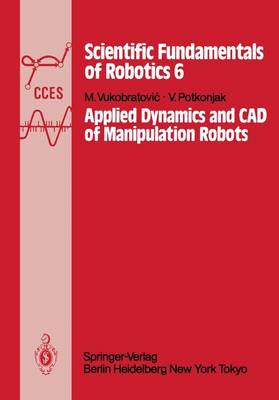Communications and Control Engineering
3 primary works
Book 1
This monograph represents the first book of the series entitled "SCI- ENTIFIC FUNDAMENTALS OF ROBOTICS". The aim of this monograph is to ap- proach the dynamics of active mechanisms from the standpoint of its application to the synthesis of complex motion and computer-aided de- sign of manipulation mechanisms with some optimal performances. The rapid development of a new class of mechanisms, which may be referred to as active mechanisms, contributed to their application in various environments (from underwater to cosmic) . Because of some specific fea- tures, these mechanisms require very careful description, both in a mechanical sense (kinematic and dynamic) and in the synthesis of algo- rithms for precise tracking of the above motion under insufficiently defined operating conditions. Having also in mind the need for a very fast (even real-time) calculation of system dynamics and for eliminating, in principle, the errors made when forming mathematical models "by hand" this monograph will primarily present methods for automatic for- mUlation of dynamic equations of motion of active spatial mechanisms.
Apart from these computer-oriented methods, mention will be made of all those methods which have preceded the computer-oriented procedures, predominantly developed for different problems of rigid body dynamics. If we wish to systematically establish the origins of the scientific discipline, which could be called robot dynamics, we must recall some groups and individuals, who, by solving actual problems in the synthe- sis and control of artificial motion, have contributed to a gradual formation of this discipline.
Apart from these computer-oriented methods, mention will be made of all those methods which have preceded the computer-oriented procedures, predominantly developed for different problems of rigid body dynamics. If we wish to systematically establish the origins of the scientific discipline, which could be called robot dynamics, we must recall some groups and individuals, who, by solving actual problems in the synthe- sis and control of artificial motion, have contributed to a gradual formation of this discipline.
Book 4
Real-Time Dynamics of Manipulation Robots
by M. Vukobratovic and N. Kircanski
Published 2 April 1985
This is the fourth book from the Series "Scientific Fundamentals of Ro botics". The first two volumes have established abackqround for studying the dynamics and control of robots. While the first book was exclusive ly devoted to the dynamics of active spatial mechanisms, the second treated the problems of the dynamic control of manipulation robots. In contrast to the first two books, where recursive computer-aided me thods for setting robot dynamic equations where described, this mono graph presents a new approach to the formation of robot dynamics. The goal is to achieve the real-time model computation using up-to-date mi crocomputers. The presented concept could be called a numeric-symbolic, or analytic, approach to robot modelling. It will be shown that the generation of analytical robot model may give new excellent possibili ties concerning real-time applications. It is of essential importance in synthesizing the algorithms for nonadaptive and adaptive control of manipulation robots. If should be pointed out that the high computational efficiency has been achieved by off-line computer-aided preparation of robot equations. The parameters of a specified robot must be given in advance. This, af ter each significant variation in robot structure (geometrical and dy namical parameters) ,we must repeat the off-line stage. Thus is why the numerical procedures will always have their place in studying the dy namic properties of robotic systems. This monograph is organized in 5 chapters.
Book 6
Applied Dynamics and CAD of Manipulation Robots
by M. Vukobratovic and V. Potkonjak
Published 2 June 1985
This book is a logical continuation of Volume 1 of the series entitled "Scientific Fundamentals of Robotics" which presents all of the basic methods for computerized construction of dynamics of manipulation ro bots as well as the essential concepts of computer-aided design of their mechanics. Vol. 1 of the Series also contains the main practical re sults from the elastodynamics of manipulation robots, having in mind a need for forming a computer procedure which allows efficient checks of elastic deformations of a manipulator tip or some other of its charac teristic points. Wishing to add a highly applications-oriented dimension to the dynamic aspect of studies of manipulation robots, the authors have made a kind of a topic-based selection by leaving unconsidered some aspects of studies of robots, such as elasticity, and discussing others, more im portant in their opinion, to such an extent as suffices to make them practically applicable. The authors have decided not to treat in detail the problem of flexible manipulation robots for two reasons. The first results from the atti tude that the permissible (desired) robot elasticity may, satisfacto rily well, be tested using the method described in Vol. 1 of the Series.


